Posted by Elena del Valle on October 25, 2017
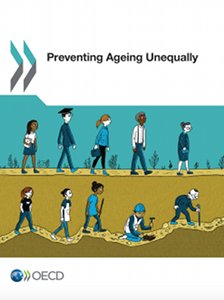
Preventing Ageing Unequally
Photos: Organisation for Economic Co-operation and Development
In the United States, employment among the prime working age population is lower now than it was in 2000, according to the Organisation for Economic Co-operation and Development (OECD). In 2000, 82 percent of 35 to 44 year old men and women worked. By 2016 only 79 percent of them worked. It is one of few countries studied by the organization where that is the case, leading researchers to conclude that is one of the main reasons for the growth of inequality.
In Preventing Ageing Unequally, a 256-page report the OECD released recently, representatives from the Paris based organization suggest that ensuring more people work for more years may result in higher retirement incomes in the future. Data in the report, which is available for online purchase as a PDF file for $42, indicate that more than four-fifths of the highly educated working age population have a job, but only about half of those with low education levels are employed.
According to the report summary, income disparities among today’s young and prime age adults are significantly higher than they were among the Baby Boomers when they were the same age. The income of the richest 20 percent of those of working age is eight times higher than that of the poorest 20 percent today.
Since incomes in retirement depend on the earnings of workers throughout their lives OECD analysts expect inequality in the working age population to lead to higher inequality among future retirees. This is particularly alarming in the United States as old age inequality among current retirees is already higher than in all other OECD countries, except Chile and Mexico. See OECD Income Inequality in Old Age chart below for details.
The report predicts that younger generations will face greater risks of inequality in old age than current retirees, and that the experience for generations born since the 1960s may change dramatically. Also since family sizes are dropping, there is higher inequality over working lives, and reforms have cut pension incomes some groups will face a high risk of poverty, the new report suggests.
Across its member countries Preventing Ageing Unequally found that in 1980, there were only 20 people aged 65 and over for every 100 of working age; by 2015 there were 28 and by 2050 the analysts projected it will almost double to reach 53. Many OECD and emerging economies are aging much faster. In the United States, the country summary indicates, there are only 25 people over the age of 65 per 100 people of working age at the moment, but this is expected to rise to 41 by 2050.
The report also anticipates that future elderly will be in more diverse situations, where people may live longer but more will have been unemployed at some point in their working lives and earned low wages, while others will have enjoyed higher, stable earning paths.
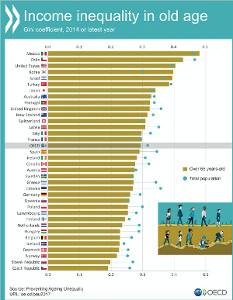
Chart: OECD Income Inequality in Old Age
Click to enlarge
Inequality begins at an early age, according to the findings. For example, a 25-year old university educated man may live almost eight years longer than his less educated peer, on average across countries; for women the difference is almost half (4.6 years). Health impacts the ability to work and earn, the report summary indicates; and over a career, poor health reduces lifetime earnings of low educated men by 33 percent and 17 percent for highly educated men.
In the United States, health problems also contribute to increasing inequality, according to the country report summary. It indicates that Americans are far more unhealthy than their peers in other countries; that people from low socioeconomic backgrounds are affected by bad health more than those from high socioeconomic ones; and that this is demonstrated by the large life expectancy gaps between high and low educated groups.
Disabilities, depression and obesity are widespread, according to the report. More than one third of American adults are obese, more than in any other OECD country. The report proposes that the authorities institute policies to target vulnerable groups as early in life as possible to prevent health, labor market and other socioeconomic disadvantages.
Preventing Ageing Unequally, published October 18, 2017, examines the development and interaction of two global mega trends of population, aging and rising inequalities, within and across generations. According to the website description, the report has 13 tables and 120 charts, shows how inequalities in education, health, employment and earnings compound, resulting in large differences in lifetime earnings across different groups; and suggests a policy agenda to prevent, mitigate and cope with inequalities. The OECD, working with over 100 countries, is a global policy forum with a mission to promote policies to improve the economic and social well being of people around the world.
Posted by Elena del Valle on October 16, 2017

Stacey Hanke, author, Influence Redefined
Photo: Stacey Hanke
A podcast interview with Stacey Hanke, author, Influence Redefined Be the Leader You Were Meant to Be (see Corporate trainer shares her ideas on influence) is available in the Podcast Section of Hispanic Marketing & Public Relations, HispanicMPR.com. During the podcast, she discusses Influence Redefined with Elena del Valle, host of the HispanicMPR.com podcast.
Stacey founded Stacey Hanke, Inc. in 2004 to provide keynotes, training, and coaching for organizations in manufacturing, healthcare, retail, advertising, financial, and insurance. She wrote Yes You Can! Everything You Need from A to Z to Influence Others to Take Action. Stacey holds a certification as a Speaking Professional for the National Speakers Association, is a Member of the C-Suite Network Advisors, and a Member of the Forbes Coaches Council.
To listen to the interview, click on the play button below, scroll down until you see “Podcast” on the right hand side, then select “HMPR Stacey Hanke” and click on the play button below or download the MP3 file to your iPod or MP3 player to listen on the go, in your car or at home from the RSS feed. Some software will not allow flash, which may be necessary for the play button and podcast player. If that is your case, you will need to download the file to play it. To download it, click on the arrow of the recording you wish to copy and save it to disk. The podcast will remain listed in the October 2017 section of the podcast archive.
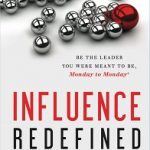
Click to buy Influence Redefined
Posted by Elena del Valle on October 12, 2017
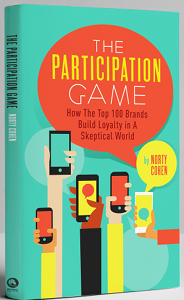
The Participation Game
Photos: Norty Cohen
Old style advertising has become an act of indecent exposure, that is out of touch with Millennial consumers and indicates the degree of desperation of the advertising brand. That is what Norty Cohen, chief executive officer, Moosylvania, believes after examining the replies of paid mobile survey respondents aged between 17 and 37. In his first book, the product of two years of labor, he outlines his thoughts on the subject.
The Participation Game How The Top 100 Brands Build Loyalty in A Skeptical World (Ideapress Publishing, $24.95), was published this year for marketers “hoping to reach millennial consumers – which is a broad 20 year demographic, born in 1980 to present.” The 226-page softcover book is divided into nine chapters with limited text, some black and white photos, varied font sizes and types, and graphic design elements.
When asked what promoted him to write a book he said by email via his publicist, “Yes – the process of writing a non-fiction book was enlightening. It starts with a thesis that can be supported in a compelling and differentiating style. Since our inception in 2003, we have served clients with both an integrated marketing agency and a research facility. Originally, we used our research tools to answer the questions we needed to better serve our clients. Once we had traction, we decided to share it with a larger audience.
The success has been that we have been able to bring our clients through a logical thought process of how to use the research we conducted over a 5 year period.
We believe there is a continued gap in understanding the deliverable of messaging. Consumers have learned to curate messages out of their life. They are their own marketers. They are in control. Media has always worked from the concept of delivery. We must now look at our connectivity with consumers as a partnership that is a living, breathing entity.”
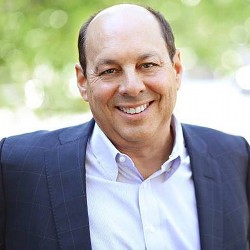
Norty Cohen, author, The Participation Game
When asked which market segments the respondents represent Cohen said, “We worked hard to get a diversified base both demographically and geographically. All surveys were mobile only. The age segments from this year’s report were in 10 year increments, 17-27 and 28-37 years old. Some years we broke it into 5 year segments but we kept it the totals and measurement even.”
The first part of the Top 100 List 2013-2017 is filled with easy to recognize company names beginning with Apple. Next in descending order are Nike, Samsung, Target, Amazon, Sony, Wal-Mart, Microsoft, Coke and Google. Because some brands tied there are more than 100 brands on the list. The last names, also in descending order, are REI, Mazda, Carter’s, Publix, Anheuser Busch and YouTube (tied), Urban Decay, Anthropologie, Subway, Johnson & Johnson & PG (tied), Guess, and Ross.
“Our research show that consumers choose to participate in brands, they do not consume advertising,” he said when asked how and why consumers adopt brands. “We found that word of mouth from friends and family, on line word of mouth, infleencers (influencers) and written reviews are 2.5 more likely to encourage brand adoption that TV, Facebook and You Tube ads combined. Consumers create the exponential reach that makes them a dominant force.”
To what is the take away for a non profit or small company on a shoestring budget – how can they develop brand recognition? he replied, “Ultimately it comes down to delivering great ideas that get consumers motivated to share with their friends. It’s not about your target market. It’s about your target’s market.”
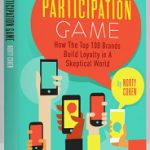
Click to buy The Participation Game
Comments:
Filed Under: Books
Posted by Elena del Valle on October 5, 2017
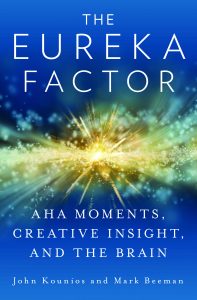
The Eureka Factor
Photos: Random House, John Kounios
There are two types of thinking, procedural and insightful, each one with its own characteristics. So say Mark Beeman, Ph.D. and John Kounios, Ph.D., psychology professors who have researched human thinking processes for more than a decade, in The Eureka Factor Aha Moments, Creative Insight and The Brain (Random House, $28).
In the 274-page hardcover book, published in 2015 and divided into 14 chapters, they outline their findings and theories about both, focusing on creative or insightful thinking. To study the brain under controlled circumstances (in the lab) the authors relied in part on remote associates problems, which may be solved using either type of thinking. Publishing their book took five years.
“The target audience is everybody,” said Kounios by email when asked about the primary target audience for the book (although Beeman replied to emails he was unavailable to answer questions for this note for personal reasons). “People in business, the arts, education, the military, etc., are all interested in creativity and its enhancement. So we tried to make the book accessible and inspirational. We also tried to make is useful for psychologists and neuroscientists by including references and technical explanations in the endnotes.”
Your mood affects your thinking; watch a feel good movie and you might stimulate your creative side, the authors say. But, on the other hand, you can’t remain on a constant loop of creative thinking. Watch the news or a horror movie to change your mood and your style of thinking too, they explain.
If someone is working on a problem, is it accurate to assume that relaxing and being in a good mood is likely to prompt insightful thinking? “Yes, this is one of those indirect ways of facilitating insights,” Kounios said. “When you are in a positive mood and relaxed, this literally expands the scope of thought to allow you to consider remote associations – crazy, long-shot ideas – that are the stuff of creativity. But when you are anxious, you have mental tunnel vision. You focus on the immediate, straightforward, and obvious. That facilitates deliberate, analytical, Type-2 thinking, but it squashes creative insight.”
Why do the types of thinking matter? Because many of us seek to control or at least learn how to stimulate our creative abilities in order to be inventive and think out of the box at work being aware of the factors that influence our style of thinking is a first type in that direction, the authors say. They point out that your surroundings also matter. Outdoor colors such as blue and green are helpful to promote insightful thinking, but red has the opposite effect.
When asked if mental training works Kounios replied, “When you ask if mental training works, I assume that you mean does it work to increase creativity. The answer is yes and no. Mental training can teach you strategies that you can use to come up with creative solutions to problems. But these strategies probably won’t make you a creative person. Cognitive psychologists distinguish between two types of thinking. Type 1 thinking is unconscious and associative. You can’t easily affect it. Type 2 thinking is conscious, deliberate, and methodical. You can be trained to learn Type-2 mental strategies, but you can’t learn Type-1 strategies because there aren’t any. Your unconscious mind doesn’t care about your strategies, deadlines, etc. It does its own thing. Aha moments, what psychologists call “insights,” are unconscious creative processes that suddenly burst into awareness. So, insights are the product of Type-1 thinking that can’t be directly influenced. However, you can sometimes use Type-2 strategies to come up with ideas. The limitation with Type-2 strategies is that they only work when you deliberately use them. When you aren’t deliberately using them, they don’t work. However, you can have a Type-1 insight anytime and anywhere, for example, while daydreaming in the shower. And these aha moments sometimes give you the answer to a problem that you didn’t even know that you had, a problem that you weren’t previously aware of. Training won’t teach you to have such aha moments, but there are indirect ways to influence your unconscious mind to have more of them.”

John Kounios, Ph.D. co-author, The Eureka Factor
“The best way is to unleash unconscious, Type-1 thinking,” Kounios said when asked what is the best way to increase creative thinking. “This is involves expanding attention and the scope of thought. To do this, get yourself in a positive mood, be in a large physical space that will allow your attention to expand such as a large room with high ceilings or outdoors; isolate yourself from demands (i.e., be alone and turn off your phone) and things that grab your attention because those your scope of thought; and get lots of sleep because during sleep the brain purges useless information and enhances potentially useful details and associations. Of course, sleep also improves your mood. The important point is to allocate blocks of time in which you are alone, relaxed, expansive, and in a good mood. Then pick a topic and let your ideas flow freely without forcing them into particular directions. This is how many great ideas occur.”
Kounios is in the early stages of a new title that looks at creativity from a broad perspective and features new research. Since The Eureka Factor was published there have been new findings.
When asked about them the author said, “Yes, several new findings which will be published in the coming months. I’ll mention just one that was recently published. We looked at peoples’ solutions to four different types of puzzles. For all of these puzzle types, when people offer a solution that they say that they got by a sudden insight, it is more likely to be correct compared to solutions that they say they derived methodically and analytically. It seems that when a person is thinking analytically, they tend to get sloppy or rush or not check their thinking, so they make mistakes. But the unconscious thinking that results in insights can’t be rushed – it occurs in its own time and yields an answer when it is complete. This means that it is more likely to be correct. That’s why genuine aha moments – ideas that suddenly pop into awareness and seem striking and obvious – are more likely to be correct than ideas that are the product of deliberate, logical thought.”
At the time of publication Beeman was professor of psychology of Northwestern University, and Kounios was professor of psychology and director of the doctoral program at Applied Cognitive and Brain Sciences and Drexel University.

Click to buy The Eureka Factor
Comments:
Filed Under: Books



















